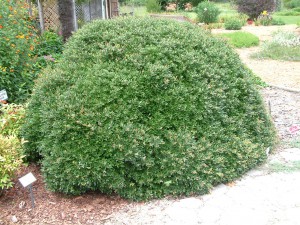
by Matt Lollar | Nov 18, 2015
Yaupon hollies (Ilex vomitoria) are evergreen, provide great fall/winter color, and can adapt to numerous landscape situations. They are also very durable and can survive extreme drought.
Characteristics
Yaupon hollies are dioecious, meaning male and female flowers are produced on separate plants and berries are only produced on female plants. Flowers are creamy white, but not showy on both male and female plants and berries can range in color from red to yellow depending on cultivar. The plants are favored by wildlife – pollinators are attracted to the flowers and birds love the berries.
Yaupon hollies are native plants with a number of different cultivars available at plant nurseries. ‘Jewel’ is a cultivar that produces an ubundance of red berries and ‘Aureo’ produces yellow berries. ‘Nana’, a dwarf, compact male cultivar is an excellent replacement for boxwoods. Large growing cultivars can grow to 15 to 25 feet tall and can be shaped as trees or left as large shrubs. ‘Folsom’s Weeping’ and ‘Pendula’ are two weeping cultivars that can be utilized as dramatic specimen trees.

Dwarf Yaupon hollies will naturally form a mound without pruning.
Credit: Beth Bolles, UF IFAS Extension Escambia County
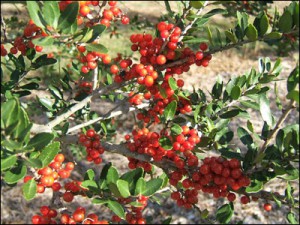
Yaupon holly fruit and foliage. Photo courtesy UF/IFAS.
Plant Care
Yaupon hollies prefer to be planted in full to partial sun. It is important to note that they are drought tolerant and require a site with well-drained soil. Because only the female plants produce berries, it is best to purchase plant material when plants contain berries in late fall and winter. Yaupon hollies spread readily by vegetative sprouts. Sprouts should be pruned down to the soil line 2 – 3 times per year. They do not have many disease or insect problems, but scale, leaf miners, mites, and aphids can sometimes be a problem.
Fun Facts
The leaves of the yaupon holly contain a higher caffeine content than any other plant native to North America. The Seminole Indians would purposely brew a concentrated “Black Drink” tea to induce vomiting and diarrhea for believed purification. Southerners utilized the caffeine in the leaves during the Civil War. If the leaves are steeped for a short period, a black tea or coffee substitute can brewed. A related species of holly (Ilex paraguariensis) from Brazil is used to make a drink called Yerba Mate, which is as popular in South America as coffee is in North America.
For more information on yaupon hollies, please visit the publication located at this link https://edis.ifas.ufl.edu/st311.
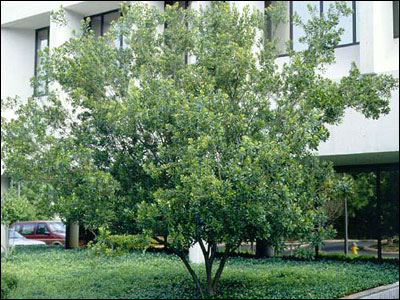
by Matthew Orwat | Nov 5, 2015

Waxmyrtle. Image Credit UF / IFAS Solutions
Myrica cerifera Southern Waxmyrtle, Bayberry is a large shrub to small tree that is now native to much of Florida and much of the Southeastern United States. It was introduced to Europeans in the 1700s and is considered native by many botanical authorities. Sources disagree to the validity of its native status. It is usually found as an understory plant in lightly forested areas, swamps, brackish areas, as well as around old home sites.
It was planted widely in the 18th,19th and early 20th century as a plant for medicinal and industrial purposes. Four pounds of its berries will yield one pound of wax for candle making. When processed, this wax was also used in surgeon’s soap, shaving lather, and sealing wax. Fermented leaves were used to produce a substance which was said to treat fever, stomach aches, and headaches.
Southern Waxmyrtle can reach up to 25 feet but is best maintained as a 10-20 foot multi-trunked shrub or small tree. It can also be trained as a smaller hedge and several dwarf form exist. Landscapes are enhanced by the shrubs’ olive green foliage, leaf aroma, open, rounded form and waxy blue-green berries. Wildlife enjoy the berries as a food source as well. They can provide dappled shade for outdoor entertainment spaces or front entrances.
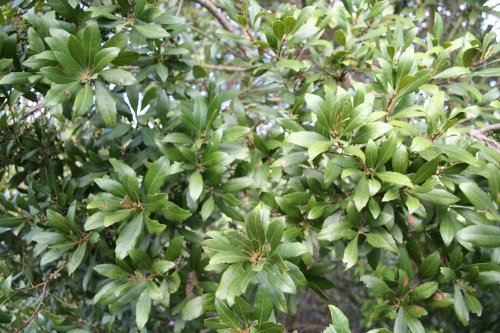
Waxmyrtle Leaves. Image Credit Brent Sellers – UF / IFAS Extension
Another benefit of Waxmyrtle is that it can be used in tough-to-landscape roadside and coastal areas since it is both pollution and salt tolerant and will cease to require irrigation once it is established. ‘Pumila’ is a dwarf cultivar suitable to small spaces.
Waxmyrtle is susceptible to few pests and diseases but can occasionally be attacked by webworms, mites and caterpillars. These can be controlled by pruning out of infested areas, forceful applications of water or Bt (Bacillus thuringiensis for caterpillar). It is also occasionally susceptible to canker on old branches and Fusarium wilt in central and south Florida. It is also considered a weed in pasture situations.
References:
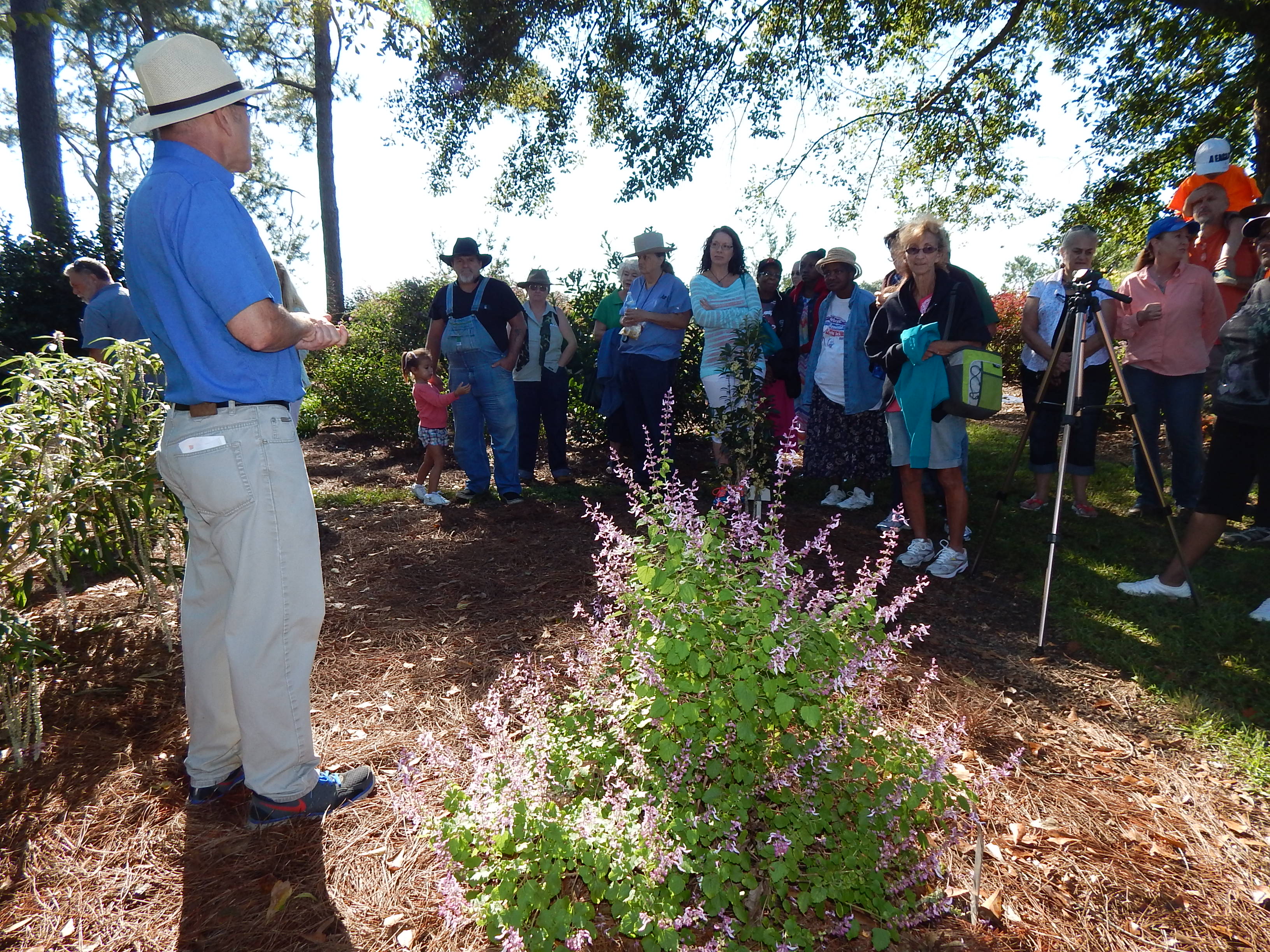
by Gary Knox | Sep 28, 2015
The University of Florida/IFAS presents Art & Garden Fall Family Festival, October 3, at the North Florida Research and Education Center (NFREC), Quincy Campus. Join us that day and discover creative ways to explore visual art and the art of gardening through demonstrations and fun activities for the whole family. Speak with experts about all your gardening questions or purchase unusual, hard-to-find, top-performing plants for our area. Take a tour of the Gardens or a trolley ride highlighting fruits and nuts that can be grown in our area. Locally grown produce and garden plants as well as arts and crafts will be for sale along with food and refreshments. Children’s arts and crafts activities will take place in a huge “Kid Zone” located in a shaded, garden area.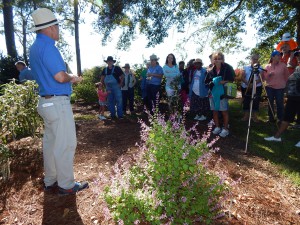
The Art & Garden Fall Festival is free and open to the public from 9 a.m. to 2 p.m. on Saturday, October 3.
The festival takes place in Gardens of the Big Bend, located in Quincy at I-10 Exit 181, just 1/8 mile north on Pat Thomas Highway (SR 267). The Gardens are located on the campus of University of Florida/IFAS, North Florida Research and Education Center, off Pat Thomas Parkway, SR 267 at 155 Research Road, Quincy, FL. Located just north of I-10 Exit 181, 3 miles south of Quincy.
Presented by the University of Florida/IFAS, North Florida Research and Education Center in collaboration with the Gadsden Arts Center, Gardening Friends of the Big Bend, the Quincy Garden Club and other area garden and arts organizations.
For more information: http://nfrec.ifas.ufl.edu/art-and-garden/ or 850-875-7100.

by Mary Salinas | Sep 24, 2015
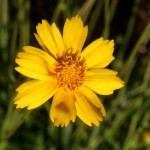
Native Lanceleaf Coreopsis. UF/IFAS Photo: Thomas Wright.
In our demonstration garden we are enjoying the small but vibrant blooms of our state wildflower Coreopsis, also commonly known as tickseed. After many years of its use in the Florida highways beautification program, Coreopsis was adopted as Florida’s official state wildflower in 1991.
Florida can boast of 16 different species of Coreopsis that occur in the state with most blooming in the spring but some species blooming in the summer to later in the fall. Some of those species are rare, endangered or only found in very limited areas of the state, while others are quite common throughout the state.
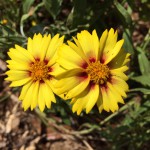
Photo credit: Mary Derrick, UF/IFAS.
Many lovely new cultivars have been introduced for our enjoyment by plant breeders through cross-breeding and selection. Some you can see in the accompanying photographs in this article.
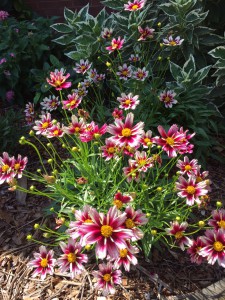
Photo credit: Mary Derrick, UF/IFAS.
Coreopsis is an annual or short-lived perennial that makes a great addition to your garden beds. And the bees and butterflies will enjoy them! The numerous flowers readily produce seed for naturalizing in the landscape. Plant them in a sunny spot in the landscape in evenly watered but well-drained soil. Removing the dead blooms will encourage plants to prolong their blooming; you can also save the seed for replanting in new areas of your landscape.
For more information:
History of Coreopsis as Florida State Wildflower
Gardening Solutions: Coreopsis
Florida Wildflower Foundation
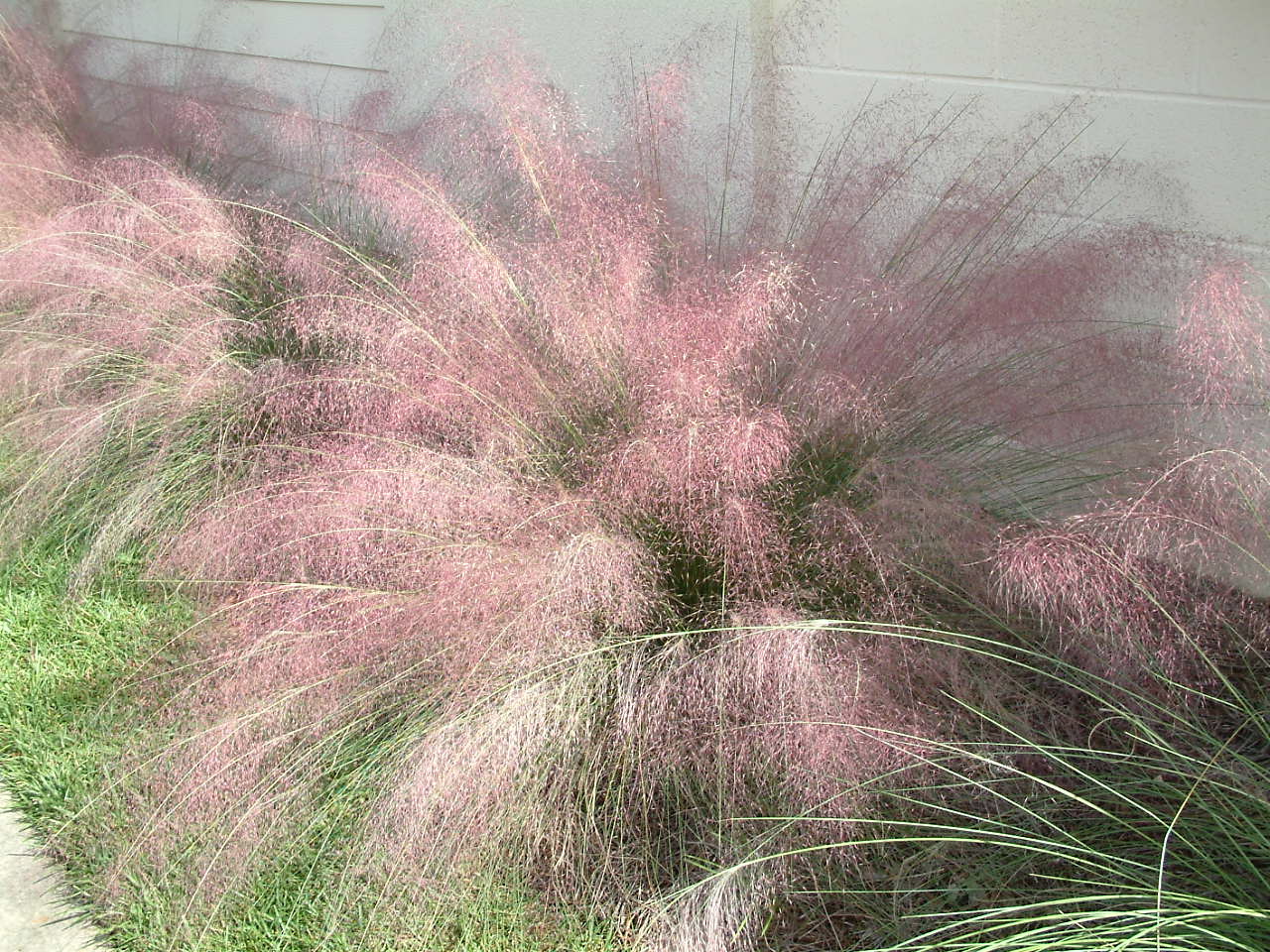
by Carrie Stevenson | Sep 23, 2015
As September rolls into October and we finally experience cooler temperatures, I always look forward to seeing one of my favorite native grasses in full bloom. Muhlenbergia capillaris, or Muhly grass, is an extremely versatile plant in the home landscape. It is both flood and drought tolerant and easy to maintain. A true local, it is typically found growing in beach dune areas, sandhills, pine flatwoods or coastal uplands. It provides nesting material and shelter for birds and small animals, and is known to attract beneficial ladybugs.
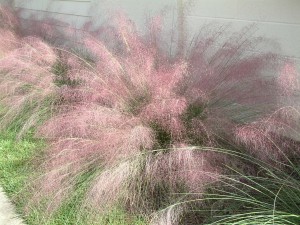
The dramatic color of Muhly grass in the fall makes it a favorite for home landscapes. Photo credit: UF IFAS Escambia Extension
Muhly grass grows in a clumping form, usually 2-3 feet in height and width, and looks great in clusters as a border along the edge of a building or lawn. It can also be used as an eye-catching centerpiece in a landscape. The plant’s most notable feature, however, appears in late September and early October. This is when hundreds of filamentous blossoms form a dramatic display of deep pinkish purple. When the wind blows the colorful blooms, it creates an appearance of a pink cloud hovering over the grass.
Muhly grass is semi-evergreen, turning more copper in color as it gets colder. The only maintenance needed is voluntary; in late winter it can be trimmed down to 6-8″ to remove older, dead blades before the growing season. This plant was chosen as the 2012 Plant of the Year by the Garden Club of America, and is a great selection for our area.
For more information on the plant, please visit UF IFAS “Gardening Solutions” or speak to your local UF IFAS Extension horticulture agent.
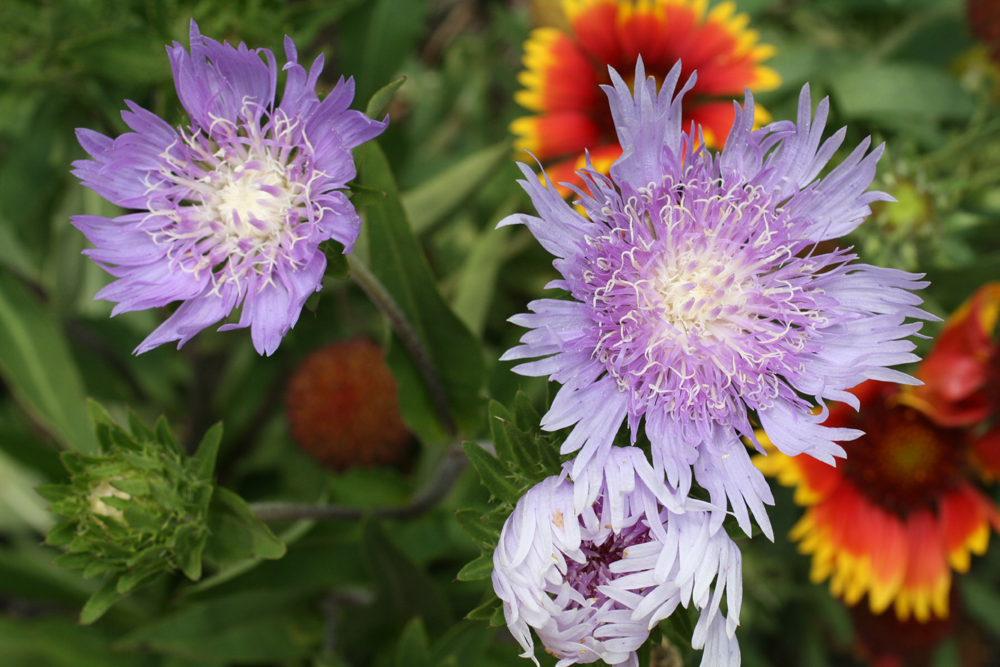
by Mary Salinas | Sep 9, 2015
After a few years, many perennial plants have grown so large that they need to be divided in order to be revived. Overcrowding causes them to bear fewer flowers and, sometimes, to die in the center. Fall is a good time to divide perennials that bloom in spring and summer and are now done blooming for the year. This is a great way also to expand your perennial beds or share some of your perennial favorites with friends and neighbors.
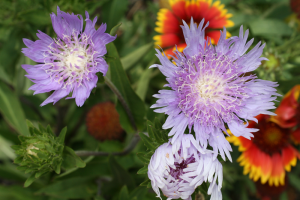
Vibrant blue Stokes’ aster. Photo credit: UF/IFAS.
Some examples of perennials to divide in the fall are:
- Stokes’ aster, Stokesia laevis
- Daylily, Hemerocallis spp.
- Black-eyed Susan, Rudbeckia hirta
- Yarrow, Achillea millefolium
- Crocosmia, Crocosmia spp.
- Flax lily, Dianella tasmanica ‘Variegata’
- Liriope, Liriope muscari
- Cast iron plant, Aspidistra elatior
The first step is to dig out the entire clump. If there is enough clearance in the garden bed, start digging about six inches out from the plant and dig straight down beyond the root zone. It’s best to get as much of the roots as possible to lessen the shock of transplanting. If the clump is too heavy to remove, make your divisions right there with a sharp blade, trowel or shovel. Often, you can just pull them apart with your hands.
Before replanting the divisions, consider adding some nutritious compost to those areas of your garden bed to ensure healthy plants. Be sure to replant as soon as feasible to protect the roots from drying out. After replanting, water the transplanted divisions well and mulch appropriately.
To explore further please see:
Gardening with Perennials in Florida
Propagation of Landscape Plants















